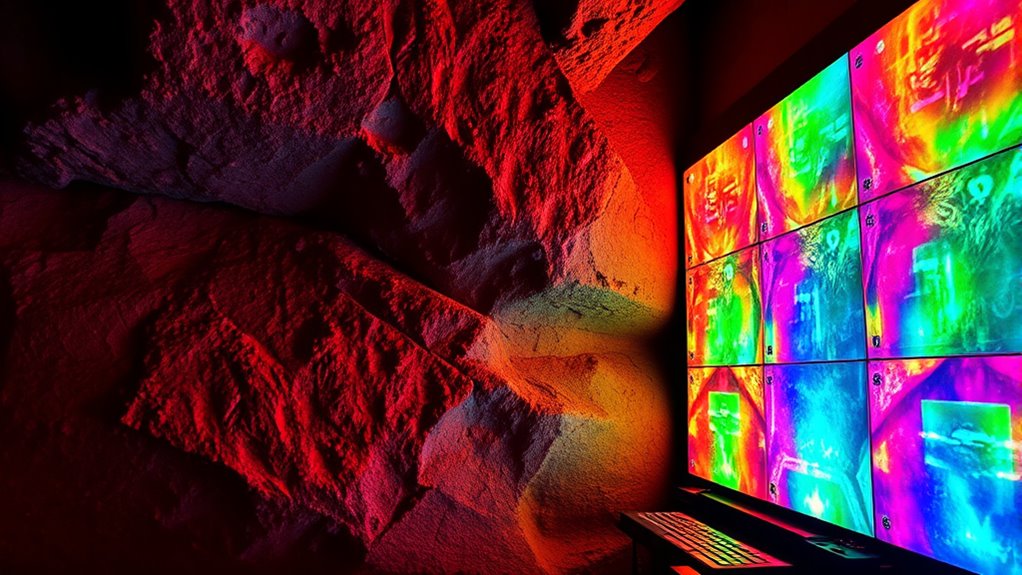Your journey from ancient cave paintings to RGB LEDs highlights humanity’s deep love for color, beginning with early pigments used for storytelling and symbolism. Over time, we’ve developed new techniques, from natural mineral dyes to synthetic pigments, and understood the science behind light perception. Today, digital screens and smart technology amplify our visual experiences. If you keep exploring, you’ll discover how this vibrant dance continues to shape art, culture, and innovation worldwide.
Key Takeaways
- Humanity’s use of natural pigments in cave paintings marked the earliest exploration of color’s cultural and symbolic significance.
- Advances from mineral-based pigments to synthetic dyes expanded artistic expression and durability throughout history.
- Scientific understanding of light and color perception has enhanced our ability to analyze materials and create vivid visuals.
- Modern technology, like RGB LEDs, enables precise, vibrant color displays, continuing the evolution of humanity’s love for color.
- Future innovations aim to deepen immersive, emotionally impactful color experiences through AI, augmented reality, and neural interfaces.
The Origins of Color in Prehistoric Art
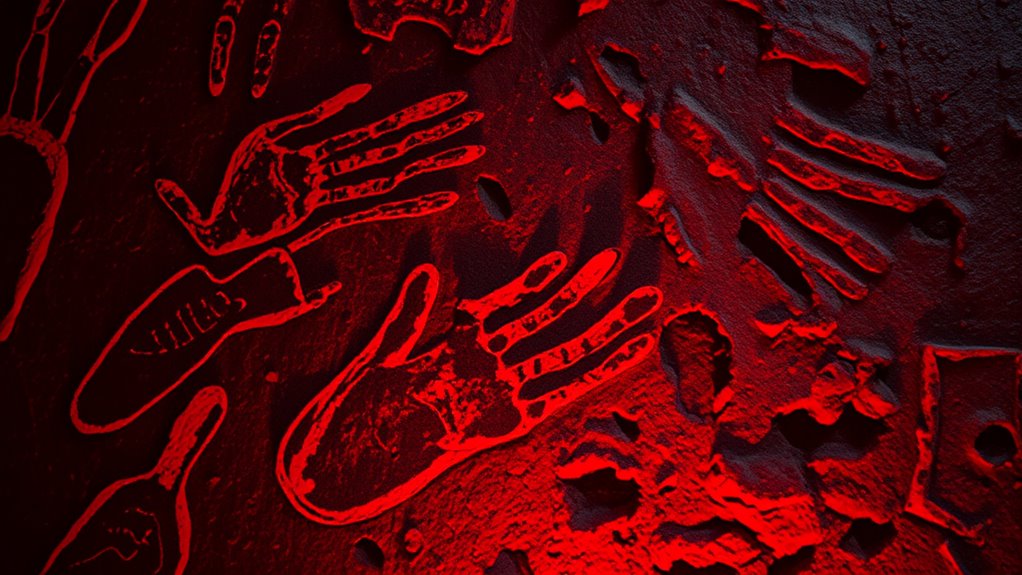
Prehistoric humans first discovered the power of color when they began using natural pigments to create images on cave walls. This pigment discovery marked a pivotal moment in human history, as it allowed early people to communicate and express ideas visually. These initial uses of color weren’t just for decoration; they carried prehistoric symbolism, conveying spiritual beliefs, social status, or storytelling. By selecting specific minerals and organic materials, they created vibrant reds, blacks, and ochres that held meaning beyond their appearance. This early experimentation with pigments shows that humans recognized the emotional and symbolic potential of color long before written language. Additionally, the choice of natural pigments demonstrates their understanding of the environment and resourcefulness in utilizing available materials. Your ancestors understood that color could evoke feelings, communicate messages, and preserve cultural identity, laying the foundation for humanity’s enduring love affair with color.
Ancient Civilizations and the Development of Pigments
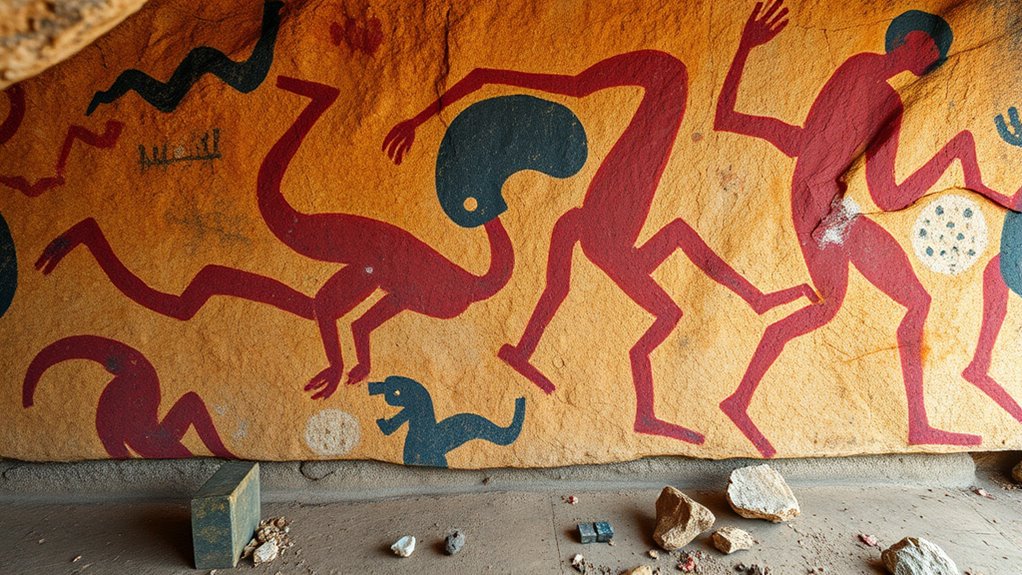
Ancient civilizations harnessed natural materials to create vibrant pigments, shaping their art and culture. You’ll see how these early dyes held deep symbolic meaning, reflecting societal values and beliefs. Exploring their innovations reveals how color became an integral part of human expression. Furthermore, the use of symbolic significance in pigment selection underscores how colors were intertwined with spiritual and cultural identities.
Early Natural Pigments
As civilizations flourished, they turned to their natural environment to create vibrant pigments for art and decoration. They discovered that natural dyes from plants and minerals could produce striking colors. Mineral pigments like ochre, malachite, and lapis lazuli were ground into powders and used in murals, textiles, and jewelry. These early materials offered durability and vivid hues, making them ideal for lasting artwork. Natural dyes, extracted from berries, roots, and bark, added rich reds, blues, and yellows to textiles and manuscripts. By experimenting with these materials, ancient artisans developed techniques that enhanced their storytelling and cultural expression. Their innovations in color preservation laid the groundwork for the diverse palette of colors we continue to explore today.
Cultural Significance of Colors
Throughout history, colors have carried deep cultural meanings that go beyond their visual appeal, shaping identities, beliefs, and social hierarchies. In ancient civilizations, certain hues became symbols of power, spirituality, or status. For example, purple dye, derived from rare mollusks, signified royalty and wealth in Egypt and Rome, embodying cultural symbolism. Color psychology influences how societies interpret these colors, reinforcing social roles or spiritual beliefs. Red often represented vitality, courage, or danger, while white signified purity or mourning, depending on context. As you explore ancient pigments, you’ll see how civilizations intentionally used colors to communicate values and social distinctions. The development of pigments played a crucial role in enabling these symbolic uses of color across different cultures. These associations persist today, revealing how deeply rooted the cultural significance of colors truly is.
The Symbolism and Cultural Significance of Color Across Societies
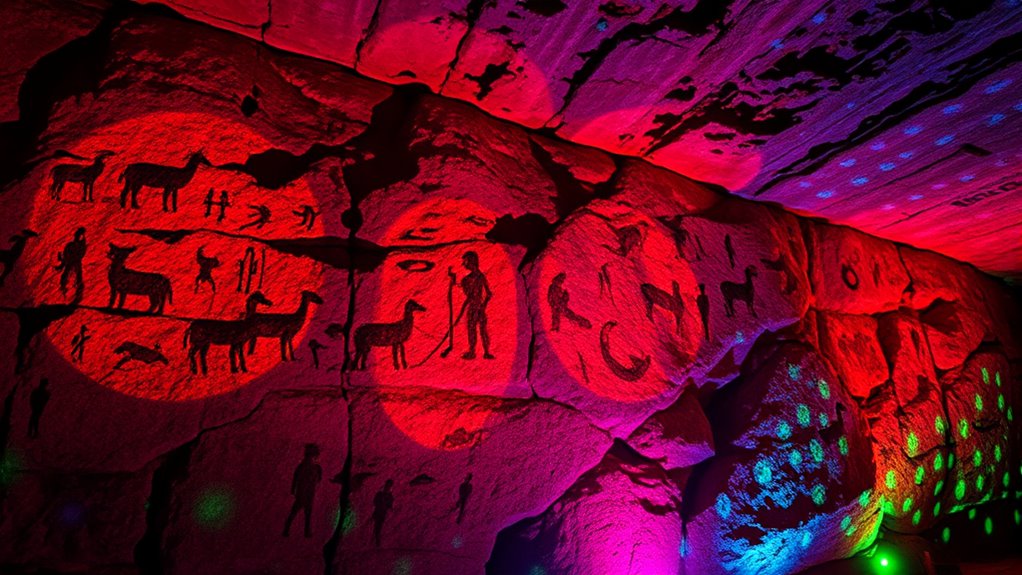
Colors carry deep symbolic meanings that vary widely across different societies, shaping how you interpret and respond to them. In some cultures, red signifies passion, luck, or prosperity, while in others, it may symbolize danger or warning. Blue often represents calm and trust, but in certain traditions, it’s linked to spirituality or mourning. These associations form part of a society’s cultural symbolism, reflecting shared values and beliefs. Colors also serve as markers of societal identity, distinguishing groups or statuses. For example, white might symbolize purity in one culture but mourning in another. Recognizing these differences helps you understand the profound role color plays in shaping cultural expressions and societal cohesion worldwide.
The Evolution of Artistic Techniques and Color Usage
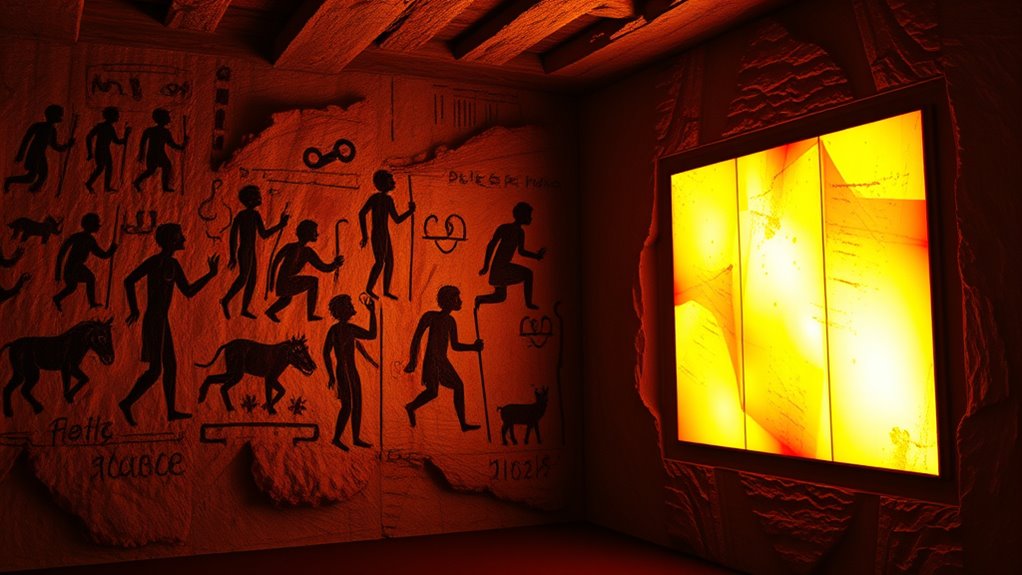
The ways artists have manipulated color over time reveal a fascinating story of innovation and adaptation. Early humans used natural pigments from earth and minerals, mastering pigment chemistry to create lasting hues. As techniques advanced, artists studied color theory to understand how colors interact and influence perception. During the Renaissance, oil paints allowed for subtle blending, expanding the palette and depth of artwork. The development of synthetic pigments in the 19th century revolutionized color usage, providing brighter and more durable options. Artists began experimenting with new applications, from pointillism to abstract expressionism, pushing boundaries of color manipulation. Today, modern techniques blend traditional knowledge with digital tools, demonstrating a continuous evolution rooted in a deep understanding of pigment chemistry and color theory. Moreover, contemporary innovations in color calibration and digital rendering continue to refine how artists and designers manipulate and perceive color across various mediums.
The Scientific Exploration of Color and Light
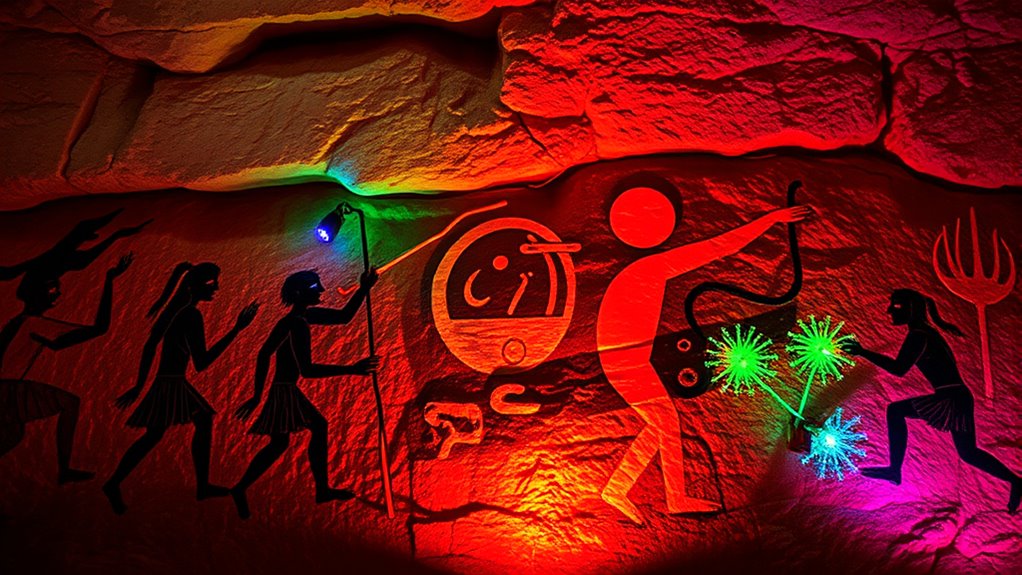
You can explore how your eyes detect color through complex mechanisms that interpret light signals. Scientists analyze the light spectrum to understand how different wavelengths create the colors you see. This research reveals the fascinating ways our perception of color is rooted in both biology and physics. Additionally, understanding visual perception helps us appreciate how our brains process and interpret these signals to produce the vibrant world around us.
Color Perception Mechanisms
Understanding how humans perceive color involves exploring the intricate mechanisms of light detection in the eye. Your retina contains specialized cells called cones, each sensitive to different wavelengths—red, green, or blue. When light hits these cones, they generate electrical signals that travel through neural pathways to your brain. This process, known as visual processing, allows you to interpret color, brightness, and hue. The brain combines signals from different cones to produce the rich spectrum of colors you see daily. To visualize this, consider the following:
| Cone Type | Wavelength Sensitivity | Color Perception |
|---|---|---|
| Red | Long wavelengths | Warm hues |
| Green | Medium wavelengths | Nature tones |
| Blue | Short wavelengths | Cool tones |
This sophisticated system forms the foundation of your vibrant visual world. Additionally, understanding how environmental factors influence color perception can deepen your appreciation for the science behind what you see.
Light Spectrum Analysis
Light spectrum analysis reveals the detailed composition of light by breaking it into its component wavelengths. This process, called spectral analysis, allows you to identify specific colors and their intensities. By examining how light interacts with materials, you can observe light absorption at particular wavelengths, which reveals information about the object’s composition. For example, when light passes through a substance, certain wavelengths are absorbed, producing an absorption spectrum. This spectrum acts as a unique fingerprint, helping scientists determine the material’s properties. Spectral analysis plays a crucial role in fields like astronomy, chemistry, and physics, enabling you to decode the universe’s light signals. Incorporating powerful persuasive words can also enhance how you communicate these scientific insights, engaging your audience more effectively. Ultimately, understanding light absorption and spectral analysis deepens your knowledge of how color and light reveal the world’s hidden details.
The Rise of Digital Displays and Modern Color Technology
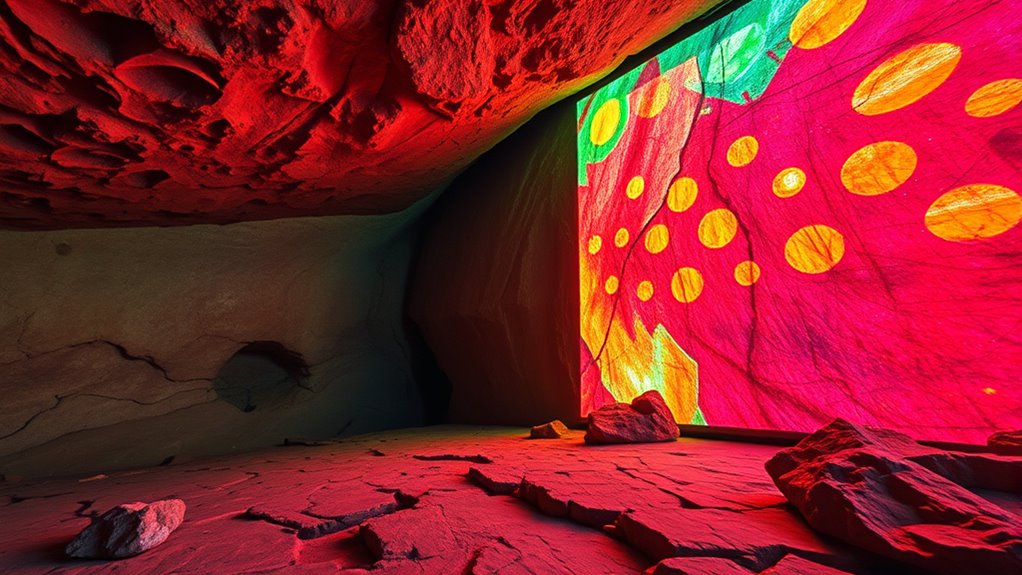
The advent of digital displays has revolutionized how you experience color, making vibrant images more accessible and dynamic than ever before. Modern screens, from smartphones to giant monitors, rely on advanced technologies like fiber optics to transmit red, green, and blue signals swiftly and accurately. These innovations enable richer, more precise colors, but they also introduce challenges like chromatic aberration, where colors don’t align perfectly, causing slight blurring or fringes. Engineers continuously improve display materials and calibration techniques to minimize these issues. As a result, digital displays deliver stunning visuals with deeper contrast and more accurate hues. This progress has transformed entertainment, communication, and visual arts, bringing a vivid world of color directly into your everyday life with unprecedented clarity and vibrancy. Harnessing AI-powered content clusters can further enhance the development and dissemination of information about these technological advances.
The Impact of Color in Contemporary Design and Media
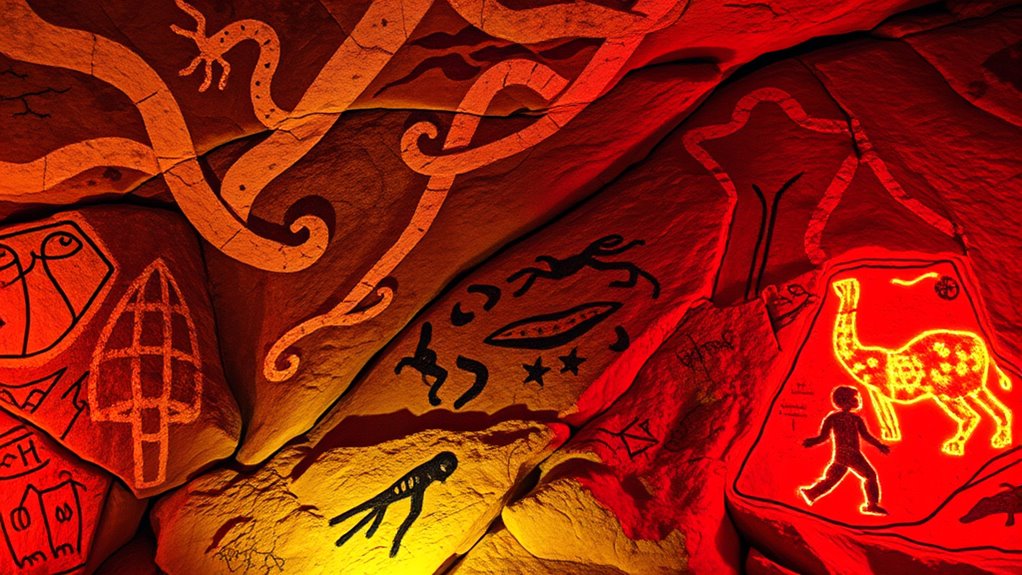
Modern design and media heavily rely on color to capture attention and communicate messages effectively. You instinctively notice how brands choose specific hues to evoke emotions through color psychology, influencing your perceptions and behaviors. Bright reds can create excitement, while calming blues foster trust. Companies carefully craft branding strategies around color to make their logos and advertisements memorable and appealing. In digital media, color guides your focus, highlights key information, and shapes your overall experience. You respond subconsciously to these visual cues, which can drive your purchasing decisions or brand loyalty. Additionally, understanding the psychological impact of color helps designers and marketers craft compelling visuals that resonate with you on a deeper emotional level, making color an essential tool in contemporary communication.
The Future of Color Innovation and Human Perception
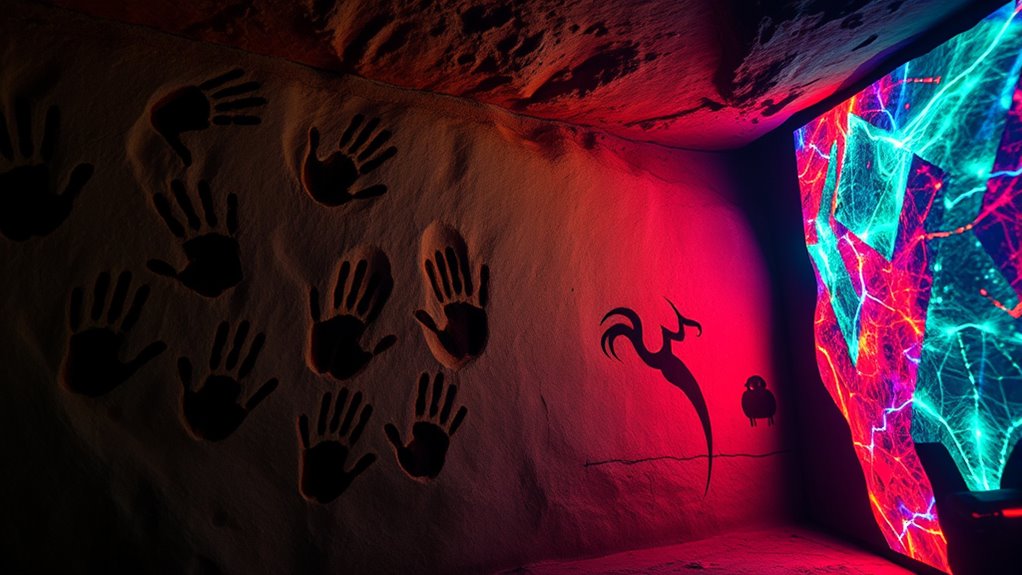
As technology advances, the way we perceive and interact with color is poised to transform dramatically. Future innovations could unbolt synesthetic experiences, blending senses and creating new perceptions of color. Imagine hearing sounds linked to specific hues or feeling textures through color displays. Color psychology will become more personalized, tailoring environments to influence mood and behavior more effectively.
| Innovation | Impact |
|---|---|
| Synesthetic tech | Enhances sensory integration |
| AI color design | Personalizes emotional responses |
| Augmented reality | Alters perception in real-time |
| Neural interfaces | Directly connects color to brain signals |
| Smart lighting | Adjusts to optimize mood |
These developments will redefine how you experience color, making it more immersive and psychologically impactful.
Frequently Asked Questions
How Did Early Humans Invent and Develop Their First Pigments?
You might wonder how early humans created their first pigments. They discovered pigment origins by experimenting with natural materials like ochre, charcoal, and clay. These ancient color tools allowed them to produce vibrant hues for cave paintings and rituals. Through trial and error, they learned to extract, grind, and apply these substances, laying the foundation for the development of more sophisticated pigments and a lasting love affair with color.
What Cultural Meanings Are Associated With Specific Colors Globally?
Have you ever wondered why red often signals danger while green symbolizes growth? Color psychology reveals that cultural color meanings vary worldwide—white can signify purity in some cultures and mourning in others. These associations shape our perceptions and behaviors, showing how deeply color influences our lives. By understanding these cultural meanings, you can better appreciate how societies use color to communicate, evoke emotions, and reinforce traditions across the globe.
How Do Different Societies Interpret and Utilize Color Symbolism?
You see that different societies interpret and utilize color symbolism uniquely, shaped by cultural color taboos and ritual color significance. In some cultures, white symbolizes purity and is used in weddings, while in others, it’s associated with mourning. You learn that understanding these cultural nuances helps avoid miscommunication and shows respect. Recognizing these varied interpretations allows you to appreciate the rich diversity of color meaning across societies.
What Are the Latest Technological Advances in Color Perception?
You’re curious about recent advances in color perception technology. Neural color processing now uses sophisticated algorithms to mimic how your brain interprets hues, enabling more accurate color rendering. Augmented reality hues allow you to experience enhanced, immersive colors through smart devices, blending virtual and real worlds seamlessly. These innovations improve visual experiences, support color-related research, and expand creative possibilities, making your interaction with color more vivid and intuitive than ever before.
How Might Future Innovations Alter Human Interaction With Color?
Did you know that over 70% of human communication is visual? Future innovations like augmented reality and neural interfaces could revolutionize how you perceive and interact with color. You might experience colors beyond visible spectrum or manipulate digital hues seamlessly. These advances could personalize your environment, enhance creativity, and improve accessibility, transforming your everyday interactions with color into immersive, intuitive experiences that blur the lines between digital and real worlds.
Conclusion
Your journey through history shows that our love affair with color is nothing short of epic. From cave paintings to RGB LEDs, humanity’s fascination with hues has shaped cultures, art, and technology. As you look ahead, imagine a future where color continues to redefine reality itself—an infinite spectrum waiting to be explored. Keep your eyes open; the world’s most vibrant innovations are just around the corner, brighter than you’ve ever dreamed possible.
